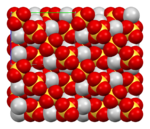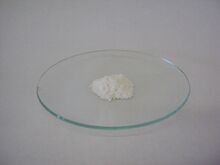Chemistry:Silver sulfate

| |

| |

| |
| Names | |
|---|---|
| IUPAC name
Silver(I) sulfate
| |
| Other names
Disilver sulfate
Argentous sulfate | |
| Identifiers | |
3D model (JSmol)
|
|
| ChemSpider | |
| EC Number |
|
PubChem CID
|
|
| UNII | |
| UN number | 3077 |
| |
| |
| Properties | |
| Ag2SO4 | |
| Molar mass | 311.79 g·mol−1 |
| Appearance | Colorless solid |
| Odor | Odorless |
| Density | 5.45 g/cm3 (25 °C) 4.84 g/cm3 (660 °C)[1] |
| Melting point | 652.2–660 °C (1,206.0–1,220.0 °F; 925.4–933.1 K)[1][5] |
| Boiling point | 1,085 °C (1,985 °F; 1,358 K)[3][5] decomposition |
| 0.57 g/100 mL (0 °C) 0.69 g/100 mL (10 °C) 0.83 g/100 mL (25 °C) 0.96 g/100 mL (40 °C) 1.33 g/100 mL (100 °C)[2] | |
Solubility product (Ksp)
|
1.2·10−5[1] |
| Solubility | Dissolves in aq. acids, alcohols, acetone, ether, acetates, amides[2] Insoluble in ethanol[3] |
| Solubility in sulfuric acid | 8.4498 g/L (0.1 molH2SO4/LH2O)[2] 25.44 g/100 g (13 °C) 31.56 g/100 g (24.5 °C) 127.01 g/100 g (96 °C)[3] |
| Solubility in ethanol | 7.109 g/L (0.5 nEtOH/H2O)[2] |
| Solubility in acetic acid | 7.857 g/L (0.5 nAcOH/H2O)[2] |
| −9.29·10−5 cm3/mol[1] | |
Refractive index (nD)
|
nα = 1.756 nβ = 1.775 nγ = 1.782[4] |
| Structure | |
| Orthorhombic, oF56[4] | |
| Fddd, No. 70[4] | |
| 2/m 2/m 2/m[4] | |
a = 10.2699(5) Å, b = 12.7069(7) Å, c = 5.8181(3) Å[4] α = 90°, β = 90°, γ = 90°
| |
| Thermochemistry | |
Heat capacity (C)
|
131.4 J/mol·K[1] |
Std molar
entropy (S |
200.4 J/mol·K [1] |
Std enthalpy of
formation (ΔfH⦵298) |
−715.9 kJ/mol[1] |
Gibbs free energy (ΔfG˚)
|
−618.4 kJ/mol [1] |
| Hazards | |
| GHS pictograms |   [6] [6]
|
| GHS Signal word | Danger |
| H318, H410[6] | |
| P273, P280, P305+351+338, P501[6] | |
| NFPA 704 (fire diamond) | |
Except where otherwise noted, data are given for materials in their standard state (at 25 °C [77 °F], 100 kPa). | |
| Infobox references | |
Silver sulfate is the inorganic compound with the formula Ag2SO4. It is a white solid with low solubility in water.
Preparation and structure
Silver sulfate precipitates as a solid when an aqueous solution of silver nitrate is treated with sulfuric acid:
- 2 AgNO3 + H2SO4 → Ag2SO4 + 2 HNO3
It is purified by recrystallization from concentrated sulfuric acid, a step that expels traces of nitrate.[7] Silver sulfate and anhydrous sodium sulfate adopt the same structure.[8]
Silver(II) sulfate
The synthesis of silver(II) sulfate (AgSO4) with a divalent silver ion instead of a monovalent silver ion was first reported in 2010[9] by adding sulfuric acid to silver(II) fluoride (HF escapes). It is a black solid that decomposes exothermically at 120 °C with evolution of oxygen and the formation of the pyrosulfate.
AgF
2 + H
2SO
4 → AgSO
4 + 2 HF
4 AgSO
4 → 2 Ag
2S
2O
7 + O
2
References
- ↑ 1.0 1.1 1.2 1.3 1.4 1.5 1.6 1.7 Lide, David R., ed (2009). CRC Handbook of Chemistry and Physics (90th ed.). Boca Raton, Florida: CRC Press. ISBN 978-1-4200-9084-0.
- ↑ 2.0 2.1 2.2 2.3 2.4 Seidell, Atherton; Linke, William F. (1919). Solubilities of Inorganic and Organic Compounds (2nd ed.). New York: D. Van Nostrand Company. pp. 622–623. https://archive.org/details/solubilitiesino01seidgoog.
- ↑ 3.0 3.1 3.2 Anatolievich, Kiper Ruslan. "silver sulfate". http://chemister.ru/Database/properties-en.php?dbid=1&id=1253.
- ↑ 4.0 4.1 4.2 4.3 4.4 Morris, Marlene C.; McMurdie, Howard F.; Evans, Eloise H.; Paretzkin, Boris; Groot, Johan H. de; Hubbard, Camden R.; Carmel, Simon J. (June 1976). Standard X-ray Diffraction Powder Patterns. 25. Washington: Institute for Materials Research National Bureau of Standards.
- ↑ 5.0 5.1 5.2 "MSDS of Silver sulfate". Fisher Scientific, Inc. https://www.fishersci.ca/viewmsds.do?catNo=S19025.
- ↑ 6.0 6.1 6.2 Sigma-Aldrich Co., Silver sulfate. Retrieved on 2014-07-19.
- ↑ O. Glemser; R. Sauer (1963). "Silver Sulfate". in G. Brauer. Handbook of Preparative Inorganic Chemistry, 2nd Ed.. 2pages=1042. NY, NY: Academic Press.
- ↑ Zachariasen, W. H. (1932). "Note on the Crystal Structure of Silver Sulphate, Ag2SO4". Zeitschrift für Kristallographie - Crystalline Materials 82 (1–6): 161–162. doi:10.1524/zkri.1932.82.1.161.
- ↑ Malinowski, P.; Derzsi, M.; Mazej, Z.; Jagličić, Z.; Gaweł, B.; Lasocha, W.; Grochala, W. (2010). "Ag(II)SO(4): A Genuine Sulfate of Divalent Silver with Anomalously Strong One-Dimensional Antiferromagnetic Interactions.". Angewandte Chemie International Edition in English 49 (9): 1683–1686. doi:10.1002/anie.200906863. PMID 20084660.
 |


